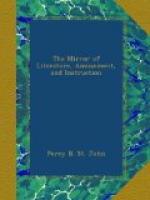* * * * *
THE SELECTOR; AND LITERARY NOTICES OF NEW WORKS.
* * * * *
ROMANCE OF HISTORY.
France. By Leitch Ritchie.
The design of moulding the romantic annals of different countries into so many series of Tales—is one of unquestionable beauty. It originated, we believe, with the late Mr. Henry Neele, who was in every sense well qualified for so poetical an exercise of ingenuity. He commenced with “England;” but, unfortunately, did not live to complete a Second Series; neither had he the gratification of seeing his design fully appreciated by the public. The “Romantic Annals of England,” on their first appearance, made but slow progress in popularity: the author trusted, and the publisher hoped, and, to use a publishing phrase, the work gradually made its way—slow but sure—if we may judge from the wished-for “new editions.” How unlike is this course of favour to the blaze of fashionable annals, or novels of high life, that are born and die in a day, or with one reading circle of a subscription library. They strut and fume in the publisher’s newspaper puffs; but their light is put out within a few brief hours, and they are laid to sleep on the capacious shelves of the publisher’s warehouse. Not so with the Tales of Historical Romance: they have fancy enough to embellish sober fact.
The second series—Spain—is from a Spanish hand of some pretension, but less power than that of Mr. Neele.
The third series—France—by another hand, is now before us. In his advertisement, the author says, when he undertook the present series, “he proposed to himself to fulfil what ‘the Romance of History’ seemed to require, by presenting a succession of romantic pictures illustrative of the historical manners of the French Nation.” We incline to his conception of the task. He further notes that “he has taken pains to go for information to the original sources of French History. These he found in reasonable abundance, in the old Collegiate Library of Caen, and in the British Museum.” There are in the Series nineteen Tales, with historical summaries where requisite for their elucidation. The titles are irresistible invitations—as Bertha, or the Court of Charlemagne—Adventures of Eriland—the Man-Wolf—the Phantom Fight—the Magic Wand—the Dream Girl, &c. Their style may be called spirit-stirring, while it has much of the graceful prettiness of love-romance.—The author, too, has caught the very air of chivalric times, and his pages glitter with the points of their glories;—not unseasonably mixed with the delightful quaintnesses and descriptive minuteness of the old chroniclers.
To condense either of the stories would be neither advantageous to the author nor reader. We therefore extract a scene or two from “the Bondsman’s Feast,” and an exquisite portrait of “the Dream Girl:”—




